Peter Calandra’s name might not be familiar, but it’s extremely likely that you’ve heard his music. He has released twelve albums, six of which are reviewed on MainlyPiano, but he has also written a large volume of music for television and films. His recently-released album,
Carpe Noctem, is a collection of original sacred music for choir and orchestra, and it’s incredibly beautiful. In this interview, we talk about that album as well as many other facets of Pete’s musical life. Enjoy!
KP: Hi Pete! Congratulations on the release of your amazing new album,
Carpe Noctem! It is certainly one of the most beautiful albums of the year. How is it being received so far?

Click on album cover to go to Kathy's review.
PC: Hi Kathy. Thank you for the kind words. The album has gotten really good reviews, including yours, and has started to get airplay. Most people seem to like it as it’s much different than my other albums.
KP: I understand that this album is something you’ve wanted to do for a very long time. Can you give some background on the project and what led you to compose the music for it?
PC: As I have mentioned in a few places, when I was an undergraduate student and singing in the choir, we sang quite a bit of liturgical music from the great composers like Palestrina, Des Pres etc. with Latin texts. It was always really inspiring to sing and planted the seed that someday it would be interesting to write music for choir and orchestra with Latin texts. Another deciding factor is the large quantity of ‘ambient/new age’ sacred albums with mantras sung in Sanskrit and that this would be a more unique approach than just another “Shanti, Shanti, Om Shanti” filled album.
KP: Thank you for that! I would imagine that with all the work you have done in film and television music, you must have some pretty nice “toys” for creating such a full rich sound. I can usually spot a digital orchestration and/or choir a mile away, but not on this album. How do you do it?
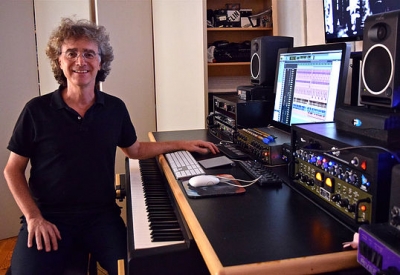
Pete in the studio. 2016
PC: That question will take more than a few words to answer! The first thing is knowing how to write music that is idiomatic for the instruments and also sounds good using the sample libraries one owns. For example, brass players need to breathe and their lips get tired from extended playing of high notes so writing long lines in the upper registers with no breaks is not realistic. Another is knowing the way an instrument sounds and speaks in each register and using that information to get the best timbre for each part. French horns have quite a wide range and can even play low notes in the lowest tenor trombone range. Unless you have a special effect you are going for, it’s best to leave those lower notes to a trombone or even a bass trombone. Also, wind, brass and string players animate the sound they create. They can, on one note, change volume, timbre and articulation over the duration of a pitch and being meticulously careful with that can really help. Finally, learning how to use orchestration to help unfold the details of a composition over time is essential. I tend to use many different articulations over the course of a piece. For example, a violin section can play soft sustains with no vibrato; with vibrato, the vibrato can change in intensity over the duration. They can play with mutes, bow over the fingerboard, by the bridge etc.. Over the last few years orchestral libraries have featured more and more articulations and it’s up to the composer to learn how to exploit and employ them to create a compelling track. The final thing that I think is unique to me is the 20 years spent playing keyboards on stage, in orchestra pits and in the studio with all sorts of instrumentalists. I have been onstage at Carnegie Hall with the NY Pops (80 players), in the Radio City Music Hall Orchestra (45 players) and in big orchestrally based Broadway shows (
Les Miz,
Phantom Of The Opera and
Miss Saigon). These opportunities came about because I could play with both a rhythm section and follow a conductor, play written music and improvise. Having to blend in when doubling string or brass sections as well as just hearing the sounds night after night played by some of the best players in the world was an experience that most composers don’t get. That experience informs how I work and detail a track to bring it to life.

Opening night of Miss Saigon 1991
KP: If there is any secret to making electronic or digital music sound acoustic is just that - learn what the distinctive qualities, ranges, and limitations are for the various kinds of instruments. One of the things I hate most about digital orchestration is that the strings so often start with an attack and almost sound like a swarm of bees.
As I understand it, the only thing you didn’t do on Carpe Noctem is some of the mixing and mastering. About how long did it take to do the album from start to finish (not counting the lifetime of experience and training!!!)?
PC: Probably 10 weeks of work spread out over 6 months. I had to fit in the production of the album between a couple of other projects and also moving house!
KP: There is a broad range of moods and expression in the music. Did you have an overall theme in mind or was it more to create a collection of sacred music?
PC: There was an overall concept for this album in terms of it being orchestral with choir singing in Latin and having each piece be almost like a chapter to a longer narrative. So while composing the music I kept notes of the feel for each piece and how the collection could work over a longer timeline. This would dictate what the set was lacking in terms of being a complete arc from the first track to the last. This info dictated what kind of pieces were needed as the work unfolded. There were also 3 pieces from my film scores that had the right feel and they reworked to fit into this album. The goal here, as it is in all of my music, is to tell a story in sound. That can work on multiple levels: the story found in a section of a composition, in an individual piece and how those stories, when set into a particular order, tell a larger narrative over a 50 minute sequence of musical events.

Click on album cover to go to Kathy's review.
KP: Earlier this year, you released Piano Improvisations, Volume 1, which is very different from Carpe Noctem. Since it is “Volume 1,” I assume there will be a series. Will “Volume 2” be all new improvisations or will they also be chosen from piano music you have improvised over the years?
PC: Volume 1 was selected from recordings made in different places and on different pianos saved over the past 15 years or so. Going forward, my goal will be to release one a year. I have a Yamaha C7 Conservatory Grand with a Disklavier system built in. This allows me to record improvisations as MIDI every day and take the best ones, tune the piano, set up my mics in my studio, have the Disklavier play them back on the piano and record them as audio to make an album.
KP: Where Carpe Noctem is on the classical side, Piano Improvisations encompasses a variety of piano styles, but probably reflects your jazz background more than anything else. Do you intentionally choose a genre to work within in your recordings or is the resulting music more of an assimilation of your vast experience in a wide variety of genres?
PC: The concept comes before before composing or improvising and that suggests the musical language that would best realize that concept. Then I work to get my rational mind out of the way, follow the music and almost let it compose itself.
KP: I’m always fascinated by all of the different ways there are to compose music, so thanks for your insights into your process(es)!
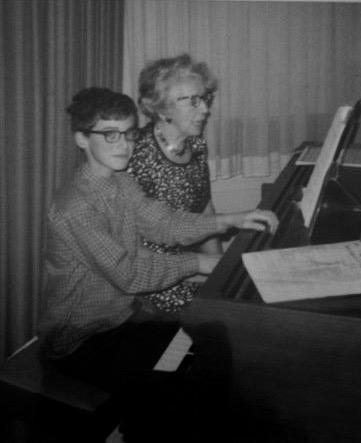
Pete and his childhood piano.
Let’s talk about your background a bit. Where did you grow up?
PC: I was born in Brooklyn and grew up in a beach village in NY on the north shore of Long Island.
KP: When did you start playing the piano?
PC: We got a piano when I was six and I started picking things out by ear and then had lessons on and off until my mid 20’s. I also sang in the choir, played trumpet and percussion in school ensembles until about 8th grade.
KP: When did you start writing music?
PC: I have vivid memories of sitting in the classroom in elementary school with manuscript paper writing notes down because I liked the way it looked. My first real piece came at about age 16 but did not start focussing in on regularly creating music until my mid 20’s when I put together my first midi ‘studio’, 4 track cassette deck and sequencer set up.
KP: When did you start playing professionally?
PC: My first bar gig in a blues rock band came a few weeks before my 16th birthday and by age 18 I was playing gigs in clubs most nights. There were all sorts of bands: Top 40, Lounge Bands, Funk, Reggae, Jazz, Jazz Fusion, Jam Bands, Wedding bands, accompanying singers etc.. Anything to earn a living while attending college. Back then there was a thriving live music scene on Long Island and tho it didn’t pay that much, it was much cheaper to live then and was an interesting companion ‘schooling’ to the formal college education.
KP: Some real-world experience to go with the more idealized educational setting!

Click on album cover to go to Kathy's review.
Click
here to go to Joseph's review.
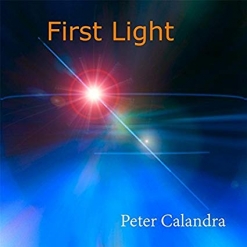
Click on album cover to go to Kathy's review.
Which other instruments do you play? (Obviously all of them, using synths!)
PC: Aside from piano/keyboards and synths, I play guitar, bass guitar, mandolin, hand percussion, some basic drums, basic recorder, blues harmonica. I actually also consider the computer an instrument and teach it to my music tech students as such.
KP: Did you grow up in a musical family?
PC: My mother was an amateur pianist and played totally by ear. She had lessons as a child but did not have access to a piano for 25 years. She was also very handy with crafts. Ceramics, crocheting, quilting, all sorts of hand crafts she would make. She actually, as a senior, taught Arts and Crafts at Adult Ed. classes.
KP: Were you a music major in college?
PC: I was a music major as an undergrad and then went back in the early 1990’s while playing Broadway shows full time to get an MA in Composition from the Copland School of Music at Queens College, CUNY where I also now teach on a part time basis. I studied composition with Thea Musgrave and George Perle, Jazz Composition and Arranging with Jimmy Heath and Orchestration and Theory with Sol Berkowitz. An amazingly talented and diverse set of educators.
KP: When did you start scoring films? Any favorites?
PC: The first paid composing job was in the late 1980’s writing music for a series of foreign language cassettes for kids by Berlitz. There was also the odd video scoring job in the 1990’s. The first actual feature film I scored was in 2001 titled
13th Child, The Legend Of The Jersey Devil. This film was a horror/thriller that played in the theaters for a month or two. A few of my favorite films are:
Rise 1961 that was a documentary about the 1961 United States Skating team that infamously died in a plane crash in Europe and the aftermath. It was a really well made and touching tribute/documentary and was a Fathom Event and the original screening was simulcast to 600 theaters across the USA. The score for that was “Americana” orchestral music. There were 2 indy films in 2004 and 2005 that both won the Los Angeles Film Festival,
Unknown Soldier and
Jellysmoke. They were urban dramas that told the stories of troubled youth with a positive ending. I was able to write jazz based music, Brazilian music and ambient music for those. I also scored two documentaries for ESPN titled
Unmatched and
Pat XO.
Unmatched (2010) was Chris Evert and Martina Navratolova discussing their rivalry and lifelong friendship. Quite a bit of archival footage to go along with the story and I was able to write an electronica score for that one.
Pat XO (2013) was the life story of the late women’s basketball coach Pat Summit (one of the greatest and most successful coaches). She had been diagnosed with early onset Alzheimer’s and the story was affectionately told by her son and former players. The film was selected for the Tribeca Film Fest and that was a fun screening! It was a very touching story and I got to write a ‘rootsy’ score featuring quite a bit of acoustic guitar work that I wrote and played. It was both a challenge and quite a bit of fun. I have also scored many inspirational short films for ESPN’s Special Olympics World Games and Invictus Games that feature amazing people who have overcome adversity to have a successful life. I’ve scored about 80 films overall.
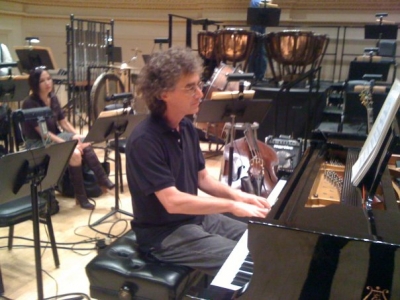
Pete in rehearsal at Carnegie Hall 2012
KP: Impressive! How did you get into writing music for television? It looks like you’ve written a lot of music for sports programs. Any favorites of these?
PC: Around 1998 I started composing “Production Music” for NBC Sports, Fox Sports and Killer Tracks thru a NYC based music producer. I wrote about 1000 two minute tracks over a period of 10 years. All kinds of music: Acid Jazz, Solo Piano, Drama, Comedy, Lounge, Hi Tech, News, Highlight Music etc. I also arranged and composed additional music for an ABC Sit-Com “Hope and Faith” for one season (2004). I was also on the show playing piano on my arrangement of Cole Porter’s “You’re The Top” with Kelly Ripa singing (
https://www.youtube.com/watch?v=q2jmNveB7Cc). That was quite a bit of fun. This led to opportunities for composing theme songs for Network Sports programs on ESPN, Fox Sports, The MSG Network, The Big Ten Network, Comcast SportsNet, SNY (SportsNet NY) and others. I’ve written about 45 theme songs for television shows over the past 14 years or so. In fact, I just finished a new theme song for a show on SNY in NYC titled “Geico SportsNite: Live On SNY”. That went on the air after Labor Day. My favorite 4 theme songs are the Special Olympics World Games Theme for ESPN, The Invictus Games Theme, also for ESPN and for FOX Sports the FIFA World Cup Theme. The 4th one is the Sportsnite Theme for Comcast SportsNet (different than the SNY one).
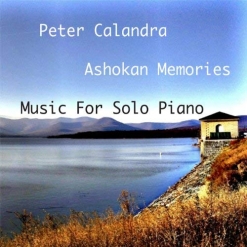
Click on album covers to go to Kathy's
reviews.
KP: You’ve also played in the “pit” for a number of musicals on and off Broadway. Any favorites?
PC: The show with the longest run that I was a full time member of was the original Broadway production of Miss Saigon. I was the principal keyboard player (Key 1) of the show for 10 years to the day. My absolute favorite, without a doubt was the original Off Broadway production of Little Shop Of Horrors. It’s really hard to describe the scene back in the mid 1980’s in the East Village of NYC where the show was playing but it was incredible. I loved the show, the cast was amazingly talented, the band was fabulous and I made life-long friends there. The theater was small (325 seats) and for the first few years, sold out every night. Being the ‘it’ show in NYC for a couple of years, dozens of famous celebrities from Yoko Ono and Sean Lennon to Michael Jackson to Eddie Murphy, Lucille Ball, Robert Redford, Cher, Jamie Lee Curtis and many others would come to see the show. After the show there was usually a ‘meet and greet’ with them which was very cool. The band was very visible in the house and we had people sitting 2 feet away from us while playing the show. I started there as a sub a couple of months after graduating from college in 1982. The band was 4 players: Piano/Conductor, Electric Keyboards, Bass and Drums/Percussion. The Electric Keyboard book was Fender Rhodes piano, Korg CX3 organ and Korg Poly6 synth. The keyboard book was tricky to play but well written and once I got it down, fun to play. After about 8 months of subbing on that chair, I took over full time. Eventually, I learned the Piano/Conductor book and took over full time as Music Director/ Pianist and Conductor of the show for the last 2.5 years of the run. I stayed there for 5 years.
KP: It seems like it could be grueling to play the same music night after night for years at a time. How do you keep it interesting for yourself?
PC: When younger, it was much easier to keep things fresh as the entire scene was so vibrant, exciting and new. As I got older, the different shows all seemed to run into each other so that after a few months of one, it felt like you had been playing it for years.
Miss Saigon really burned me out. The piano book was very exposed, very difficult and physically exhausting. Each night I set my intention to work on one thing. One night could be making my left hand be as clean and clear as possible. The next night try and play as closely with the string section as possible etc. The most important part of that book was the time feel as the book was the rhythmic base for most of the show and it was very important (while following the conductor) to drive the show from the keyboard book. After 10 years of that and playing about 3000 shows out of the 4000 total performances I couldn’t look at a piano for several months after the show closed.
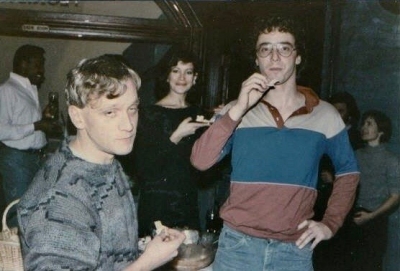
Pete with Howard Ashman at "Little Shop of Horrors" - about 1986
KP: I can only imagine! Have you written any musicals yourself?
PC: No. While playing shows has influenced and taught me the importance of creating music that is in the service of storytelling, composing vocal songs is not my strong suit.
KP: I’ve talked to quite a few composers over the years who thought their music would be ideal for film, but when it came down to it, the exacting specifications needed for film just about drove them crazy. I would imagine that composing for film would be more of a craft than an art - especially if the music is not supposed to distract from whatever is happening in a movie. How do you feel about that?
PC: Many people create music that ‘sounds like film music’. That is a distinctly different skill set than creating a compelling score that compliments, drives and underscores the arc of a narrative and helps a story unfold. Also to make generalizations about what a film score should do beyond help tell the story is not really helpful. The score for a film like
Paris, Texas by Ry Cooder is a vastly different musical language than Bernard Hermann’s score to
Vertigo and that is a vastly different musical language than Jerry Goldsmith’s score to
Chinatown as well as the Atticus Ross/ Trent Reznor score to
The Social Network. Four very different scores in very different styles but all perfect for the films they were composed for. I also dispute the common wisdom that a score should not distract from what is happening in the movie. There are times where it should distract and overtake, times that it should barely be heard and every shade in between. So for me, it requires craft, artistry, an understanding of storytelling and many other skills that are light years beyond writing a piece of music that “sounds like film music”. There is also an entire set of non-musical skills like collaborating with a director, working with people who know very little about music and being able to take what they tell you they want and translate it into the right music for a successful score.
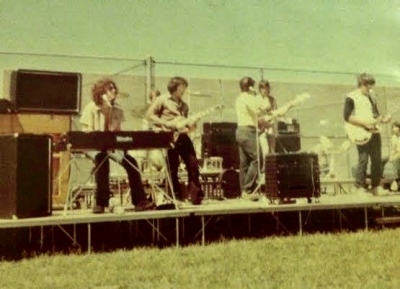
With the Free Spirit Band in 1978
KP: It must be liberating to then be able to compose whatever you want without anyone telling you what they need for their own projects!
PC: Actually, unless I am improvising at the piano, it takes a bit of time to transition into creating without a visual and narrative to define the form and dynamics of a composition. Once I get there tho, the work flows pretty seamlessly. The main difference is getting away from the structure of a film team and being able to create narratives without worrying if the melody or percussion gets in the way of dialog or sound effects as well as not having many layers of approvals to go thru.
KP: Do you have any plans for your next solo projects?
PC: Aside from another solo piano project, I am considering an album that is more electronic in nature as I have a really nice collection of analog synths that sound amazing and that is another project on the back burner for a while.
KP: You are also an assistant professor at the Aaron Copland School of Music at Queens College in New York, teaching both graduate and undergraduate students. Which classes do you teach?
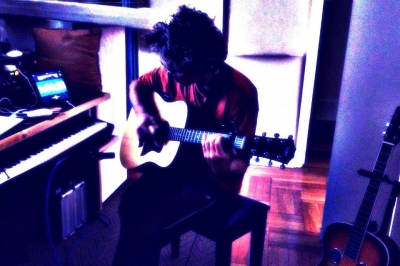
In the studio with guitar, 2011
PC: I am starting my 7th year as an adjunct professor there. I helped create the new Music And Production program that is an undergraduate minor and a graduate certificate. Most of my classes have a mix of undergraduate and graduate students in them. There is a 2 semester course of ‘Audio/Midi’ which takes students through all the basic techniques needed to create, record and mix music in a DAW (Digital Audio Workstation). I also teach a Film Scoring Class, Music For Media Class, undergraduate Composition Classes and private composition lessons for graduate students. The workload is usually two classes (6 credits) and a private student or two a semester. The work is enjoyable and I have met some amazingly talented young students from all over the world in these classes.
KP: You mentioned in a couple of videos that you recently posted on Facebook that you are at something of a crossroads in your career. Do you want to talk about that?

Playing with NY Pops Orchestra at Carnegie Hall, 2013
PC: Nothing really stays the same as time passes and a person evolves. Things that were once satisfying to a creative person become less so and new endeavors become more interesting. The unifying factor thru all the different facets of my career (except for a couple of years of touring) has been New York City. All great cities evolve and change over time. Over the last 15 years or so, NYC has undergone some of the most dramatic changes I have ever seen. Some of those changes are for the better. It’s cleaner than ever before, it’s safer and Central Park is beautiful. That being said, many changes are taking the soul out of the city. Just this last week an icon of the city, The Village Voice, stopped publishing. On 57th Street there is a flurry of new high-rises going up that only billionaires can afford. There are countless apartments that have been bought by people and entities that do not actually live in the city or the United States creating kind of urban ‘ghost’ neighborhoods. Many long time specialty stores have closed up due to rent increases and Amazon. These stores stay vacant or some sort of national chain goes in. It’s always been expensive to live in the city but even more so now and the only new people that can afford to live there are people who have making money as their main concern. Young people are spread out all over Brooklyn and Queens or are fleeing to Los Angeles where they have better weather and for the same price can share a house and not a small apartment.
There have been many articles written about this in recent times. NYC has been for 50-60 years or more the creative capital of the world and that has changed. Just think about what it must have been like to be able to walk down 52nd Street and see Charlie Parker, Miles Davis, Art Tatum or Dizzy Gillespie playing on the same night in a different club. At the end of the 1950’s Thelonious Monk played 6 nights a week (many of those with John Coltrane in his group) at the 5 Spot in the Bowery. What it must have been like in the 1950’s and 1960’s when DeKooning, Larry Rivers, Jasper Johns, Rauschenberg, Rothko, Motherwell and many others were living in Chelsea, the East Village or SOHO and were creating masterpieces. How about the folk scene in Greenwich Village in the 1960’s that produced Bob Dylan or the punk rock scene at Maxi’s and CBGB’s in the mid to late 1970’s that produced the Talking Heads, The Ramones, Television and a slew of other influential acts. When I was a teenager there was a thriving studio scene in NYC where great players did 3,4 and sometimes 5 sessions a day playing on all sorts of music. All these scenes are no longer and what is left has to be commercially viable or else it won’t survive.
There was a time where new artistic efforts could afford to develop but not now. The upshot of this is that while NYC is busier than ever in some ways, it is much less vibrant and almost, dare I say, boring on a creative level. For me personally, this has led to a bit of a crossroads. My musical life in NYC has gone just about as far as it could and the kinds of gigs available to me as both a composer and player are not as interesting as they once were and they pay less for more work. The pressure of having to work constantly in order to pay for a living situation where 2 adults, a dog, a recording studio and a 7’6” piano were crammed into a NYC one bedroom apartment got untenable. My wife and I both want to do something different and have a new adventure. The process of making albums and putting them out is enjoyable and as long as a couple of cuts get added to SiriusXM for broadcast, they pay for themselves.
As far as everything else, I am in the process of looking for a new creative outlet for my musical endeavors and to focus energy in just a couple of places. There were many times between 1998 and now where I was teaching 6 credits a semester, playing shows at night and working on multiple writing projects for films and television all simultaneously. The equanimity required for that amount of output was both fierce and tiring. In the late spring we moved out of NYC 70 miles north and bought a house in a small college town in the Hudson Valley. We now have much lower living expenses and can afford to take a bit of time and figure out what is next in the music world. I’ll keep teaching one day a week for the time being and take a few select writing projects that are beneficial and not overly involved. The upshot from all this is to create something both artistic and successful that I can enjoy and not something in service of someone else’s project. What that ends up being, I don’t know yet but the journey should be interesting!
KP: Indeed! Thanks so much for your very candid and informative answers, Pete! It’s been a pleasure!
For more information about Pete Calandra and his music, be sure to visit
his website and his
Artist Page here on MainlyPiano.com.
Kathy Parsons
September 2018










